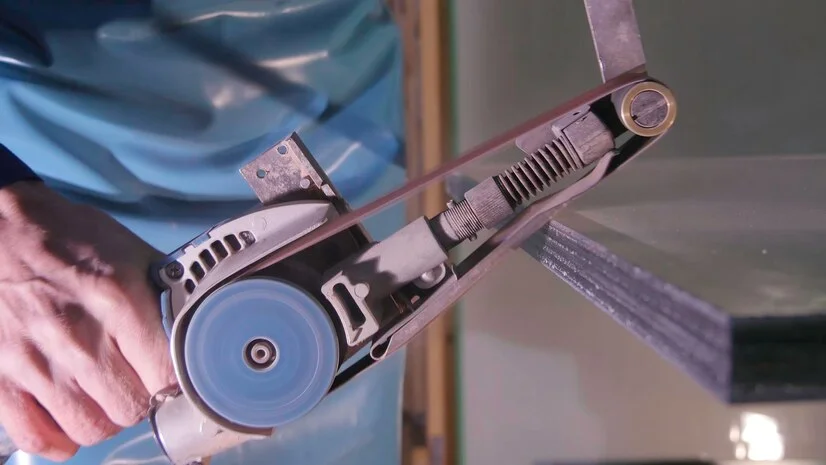When it comes to floor sanding, choosing the right tool is crucial for achieving a smooth, professional finish. Floor sanding tools are designed for different purposes, and using the best one can make the job faster and easier. Some of the popular sanding tools include belt sanders, edger sanders, and orbital sanders, each with unique uses and benefits.
A common question is whether a belt sander can replace an edger sander for floor edges. While a belt sander is powerful, it may not be the best choice for reaching corners and edges as precisely as an edger sander. Let’s explore the differences between these tools to see if a belt sander could be an effective substitute for edge sanding.
Understanding the Purpose of Different Sanders
A belt sander is a powerful tool used for quickly removing layers of wood. It moves in a straight line, making it great for smoothing large, flat surfaces. With high speed and power, a belt sander can sand down rough floors fast.
An edger sander is designed to reach tight spots, especially corners and edges of a room. This sander’s smaller, circular shape lets it work close to walls where larger tools can’t reach. The floor edger sander is essential for completing a floor sanding project evenly.
Tools like floor edge sanders are often available for rent, such as at Home Depot, making them easy to access. These rentals are specialized for edge work, so users don’t have to buy a new tool for one-time projects. Renting an edger sander is a budget-friendly option for handling detailed edge work.
Key Differences: Belt Sander vs. Edger Sander
A floor edger is small and circular, perfect for reaching corners, while a belt sander is large and straight, great for sanding flat areas quickly. An orbital sander moves in small circles, making it ideal for light, even sanding on finished wood.
Each sander has its ideal use for hardwood floor finishing. The belt sander smooths large sections of flooring, removing layers efficiently. The floor edger handles edges and corners, while the orbital sander is best for a gentle, final finish on hardwood.
For those sanding floors often, a floor edger for sale can be a good investment. Professionals and homeowners can own their tools for frequent projects. Owning an edger makes it easy to handle touch-ups anytime.
When (and When Not) to Use a Belt Sander on Floor Edges
A belt sander isn’t ideal for edge work because it’s hard to control in tight spaces. Its large, flat design makes it difficult to reach corners precisely. For detailed areas, a smaller, specialized tool is usually better.
The disadvantages of a belt sander include less precision and difficulty in handling near walls. It can easily remove too much material, which can lead to uneven edges or even gouges. Using it on the edges requires extra caution to avoid mistakes.
To prevent floor damage, don’t press too hard or leave the belt sander in one spot too long. Moving it evenly across the surface is key. Avoid using it in corners or edges where a more delicate touch is needed.
Can a Belt Sander Replace a Planer or Edger?
A belt sander cannot fully replace an edger sander because it doesn’t reach tight corners or edges well. The edger sander is specifically designed for those small spaces, where precision is essential. A belt sander works best on open, flat areas of flooring.
Some wonder if a belt sander can replace a planer, but they are different tools. A planer removes thicker layers and shapes wood, while a belt sander only smooths surfaces. For shaping wood, using a planer is still the best choice.
To use a belt sander effectively, focus on flat surfaces only and keep it moving evenly. Avoid pressing down too hard, as it can create dips in the floor. Moving in steady, even strokes will give you a smooth, professional finish.
Limitations and Alternatives to the Belt Sander
A belt sander has limitations when used on edges and tight corners. Its size and straight design make it hard to control in small spaces. For detailed areas, using a smaller tool is more effective.
A belt sander lacks finesse for creating a smooth final look compared to a finishing sander. The finishing sander moves in gentle circles, making it better for giving floors a polished appearance. It’s ideal for delicate work after the heavy sanding is complete.
While belt sanders can remove wood quickly, they are not precise for detailed edge sanding. They’re best for large, flat surfaces, where speed and power are needed. For precise edge work, an edger or finishing sander is a better option.
Choosing the Right Sander for Your Project
Choosing the right sander depends on your project’s specific needs. A belt sander works well for large, flat areas, while an edger sander is best for tight corners. Renting from stores like Home Depot or a hardwood floor edger rental service is a great option if you only need the tool for a short time.

When deciding to buy or rent, consider the pros and cons of each. Renting is cheaper for short-term projects and allows access to high-quality tools without a large investment. Buying, however, is convenient if you plan to do multiple projects over time.
Renting also provides flexibility to try different sanders before buying. You can see which type works best for your needs without a big commitment.
Bottom Lines
An edger sander is typically better for edges than a belt sander because it’s designed for precision in small spaces. The edger sander can reach tight corners where a belt sander struggles. Using the right tool for each part of the floor helps achieve a professional, even finish.
Choosing the correct sander is important for making sanding easier and more effective. Renting specialized equipment, like an edger sander, can be a smart choice for one-time projects. By selecting tools wisely, you can save time, money, and achieve the best results for your flooring project.
Frequently Asked Questions (FAQs)
Q1. Can I use a belt sander instead of a planer?
A belt sander cannot fully replace a planer because they do different things. A planer is used to shape and level wood. A belt sander only smooths the surface, so it’s better for sanding, not shaping.
Q2. What are the disadvantages of a belt sander?
A belt sander can be difficult to control and may damage edges if not used carefully. It’s also not very precise for small or detailed areas. Belt sanders are best for large, flat surfaces only.
Q3. Is a belt sander better than a finishing sander?
A belt sander is better for quickly removing lots of wood, while a finishing sander is for smooth final touches. Finishing sanders are more gentle and leave a polished look. For a finished surface, the finishing sander is usually the best choice.
Q4. What not to do with a belt sander?
Do not press too hard or keep the belt sander in one spot for too long. This can create dips or damage in the wood. Always keep it moving to avoid uneven spots.
Q5. What are the limitations of a belt sander?
A belt sander is not good for edges, corners, or detailed areas. It’s large and powerful, so it’s easy to over-sand by accident. Belt sanders are best for wide, flat areas, not small spaces.
Q6. Can a belt sander remove wood?
Yes, a belt sander can remove wood quickly because it’s very powerful. It can take off rough layers and smooth down wood fast. Just be careful not to remove too much wood at once.








I loved as much as you will receive carried out right here The sketch is tasteful your authored subject matter stylish nonetheless you command get got an edginess over that you wish be delivering the following unwell unquestionably come further formerly again as exactly the same nearly very often inside case you shield this hike
Wow superb blog layout How long have you been blogging for you make blogging look easy The overall look of your site is magnificent as well as the content